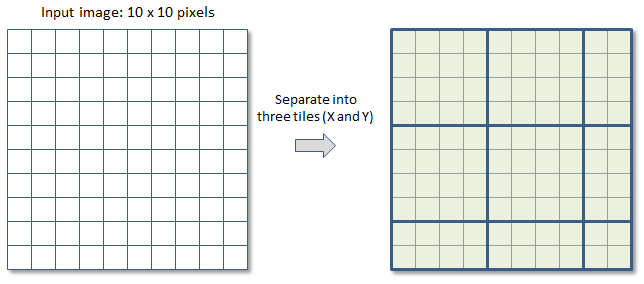DiceRasterByTileCount Task
This task separates a raster into a specified number of tiles in the X and Y direction. You can optionally create a vector shapefile that shows the tile boundaries.

Example
; Start the application
e = ENVI()
; Open an input file
File = Filepath('qb_boulder_msi', Subdir=['data'], $
Root_Dir=e.Root_Dir)
Raster = e.OpenRaster(File)
; Get the task from the catalog of ENVITasks
Task = ENVITask('DiceRasterByTileCount')
; Define inputs
Task.INPUT_RASTER = Raster
Task.NUMBER_OF_X_TILES = 4
Task.NUMBER_OF_Y_TILES = 3
Task.TILE_GRID_VECTORS = 'true'
; Define the output directory
Task.OUTPUT_DIRECTORY = Filepath('', /TMP)
; Run the task
Task.Execute
; Get the collection of data objects currently in the Data Manager
DataColl = e.Data
; Add the output to the Data Manager
DataColl.Add, Task.OUTPUT_RASTER
; Display the results
View1 = e.GetView()
FOR i=0,N_Elements(Task.Output_Raster)-1 DO $
Layer = View1.CreateLayer(Task.OUTPUT_RASTER[i])
vectorLayer = View1.CreateLayer(Task.OUTPUT_VECTOR)
View1.Zoom, /FULL_EXTENT
Syntax
Result = ENVITask('DiceRasterByTileCount')
Input properties (Set, Get): INPUT_RASTER, NUMBER_OF_X_TILES, NUMBER_OF_Y_TILES, OUTPUT_DIRECTORY, TILE_GRID_VECTORS
Output properties (Get only): OUTPUT_RASTER, OUTPUT_VECTOR
Properties marked as "Set" are those that you can set to specific values. You can also retrieve their current values any time. Properties marked as "Get" are those whose values you can retrieve but not set.
Methods
This task inherits the following methods from ENVITask:
Properties
This task inherits the following properties from ENVITask:
This task also contains the following properties:
INPUT_RASTER (required)
Specify the input raster.
NUMBER_OF_X_TILES (required)
Specify the number of resulting tiles in the X direction.
NUMBER_OF_Y_TILES (required)
Specify the number of resulting tiles in the Y direction.
Example: The input image in the code example above has 1024 rows and 1024 columns. The example specifies 4 tiles in the X direction and 3 tiles in the Y direction. Since 1024 is divisible by both 3 and 4, the resulting tiles are equally sized (X: 256, Y: 342).
In most cases, the number of pixels (in both directions) will not be divisible by the specified number of tiles. For example, suppose that an image has 10 rows and 10 columns and you want to separate it into 3 tiles in the X and Y directions. Since 10 divided by 3 is 3.333, ENVI rounds up to the nearest integer (4) when creating the tiles. The last tile in each column and row will have smaller dimensions. The following figure shows how the tiles are created:

OUTPUT_DIRECTORY (optional)
Specify the output directory for the tiles. If set to an asterisk (*), the output rasters will be virtual. This will not be written to disk, and the directory will not be created. If you do not set this property, the tiles will save to the directory indicated by the ENVI Output Directory preference.
OUTPUT_RASTER
This property contains an array of output rasters. Their filenames contain the root name of the input raster with the row/column index appended in the form of RxCx. For example, R2C3 means row 2 and column 3.
OUTPUT_VECTOR
This property contains the output shapefile if you set the TILE_GRID_VECTORS property to true.
TILE_GRID_VECTORS (optional)
Set this property to true to create an output shapefile that shows the tile boundaries.
Version History
|
ENVI 5.4 |
Introduced |
|
ENVI 5.5 |
OUTPUT_DIRECTORY now supports '*', which allows OUTPUT_RASTER to be virtual output. |
API Version
4.2
See Also
ENVITask, ENVITask::Parameter, ENVISubsetRaster, CreateSubrectsFromDistance Task, CreateSubrectsFromPixels Task, CreateSubrectsFromTileCount Task, CreateSubrectsFromVector Task, DiceRasterByDistance Task, DiceRasterBySubrects Task, DiceRasterByPixel Task, DiceRasterByVector Task, ExportRastersToDirectory Task